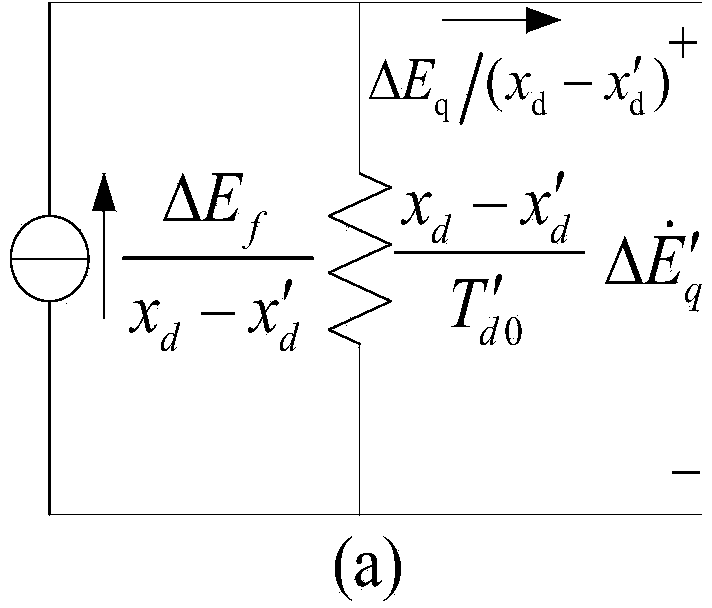Excitation system negative damping detection method based on oscillation energy injection
A technology of excitation system and oscillating energy, applied in the direction of measuring electricity, measuring devices, measuring electrical variables, etc., can solve problems such as low-frequency oscillations in power systems
- Summary
- Abstract
- Description
- Claims
- Application Information
AI Technical Summary
Problems solved by technology
Method used
Image
Examples
Embodiment 1
[0122] K=0
[0123] The excitation amplification factor of 0 means that the excitation adjustment is not performed, and the excitation voltage does not fluctuate, Δu f (t)=0. In this case the excitation system neither injects nor absorbs oscillation energy; that is to say, it provides neither positive nor negative damping to the system. This is the damping ratio of the system ζ = 0.021.
[0124] K=10
[0125] The excitation magnification is K=10, see Figure 4(a)-Figure 4(b) , the excitation voltage and excitation current when K = 10, and the excitation voltage and excitation current waveforms from 0 to 7.5 seconds at the beginning of the simulation are given.
[0126] The data from 2.5 to 7.5 seconds were selected for analysis. In this time period, the approximate number of oscillations is m=9, and the sampling period Δt=0.01 seconds. According to equations (17) and (18), the oscillation frequency f of the main oscillation mode satisfies 0.6Hz≤f≤1.2Hz. Select the identi...
Embodiment 2
[0134] K=30
[0135] The excitation magnification is K=30, Figure 6(a)-Figure 6(b) The excitation voltage and excitation current waveforms from 0 to 7.5 seconds at the beginning of the simulation are given.
[0136] The data from 2.5 to 7.5 seconds were selected for analysis. In this time period, the approximate number of oscillations is m=9, and the sampling period Δt=0.01 seconds. According to equations (17) and (18), the oscillation frequency f of the main oscillation mode satisfies 0.6Hz≤f≤1.2Hz. Select the identification program order The identification program order P=8, Table 3 and Table 4 respectively give the TLS-Esprit analysis results of the excitation voltage and excitation current.
[0137] Table 3 Analysis results of excitation voltage TLS-Esprit when K=30
[0138]
[0139] Table 4 Analysis results of excitation current TLS-Esprit when K=30
[0140]
[0141] Select an oscillation mode whose oscillation frequency satisfies 0.6Hz≤f≤1.2Hz, reconstruct the...
Embodiment 3
[0144] K=50
[0145] The excitation magnification is K=50, Figure 8(a)-Figure 8(b) The excitation voltage and excitation current waveforms from 0 to 7.5 seconds at the beginning of the simulation are given.
[0146] The data from 2.5 to 7.5 seconds were selected for analysis. In this time period, the approximate number of oscillations is m=9, and the sampling period Δt=0.01 seconds. According to equations (17) and (18), the oscillation frequency f of the main oscillation mode satisfies 0.6Hz≤f≤1.2Hz. Select the identification program order The identification program order P=8, Table 5 and Table 6 respectively give the TLS-Esprit analysis results of the excitation voltage and excitation current.
[0147] Table 5 TLS-Esprit analysis results of excitation voltage when K=50
[0148]
[0149] Table 6 Analysis results of excitation current TLS-Esprit when K=50
[0150]
[0151] Select an oscillation mode whose oscillation frequency satisfies 0.6Hz≤f≤1.2Hz, reconstruct the...
PUM
 Login to View More
Login to View More Abstract
Description
Claims
Application Information
 Login to View More
Login to View More - Generate Ideas
- Intellectual Property
- Life Sciences
- Materials
- Tech Scout
- Unparalleled Data Quality
- Higher Quality Content
- 60% Fewer Hallucinations
Browse by: Latest US Patents, China's latest patents, Technical Efficacy Thesaurus, Application Domain, Technology Topic, Popular Technical Reports.
© 2025 PatSnap. All rights reserved.Legal|Privacy policy|Modern Slavery Act Transparency Statement|Sitemap|About US| Contact US: help@patsnap.com



